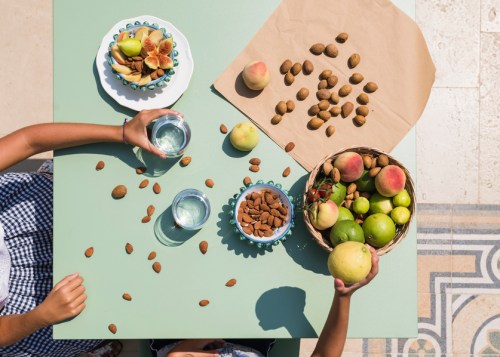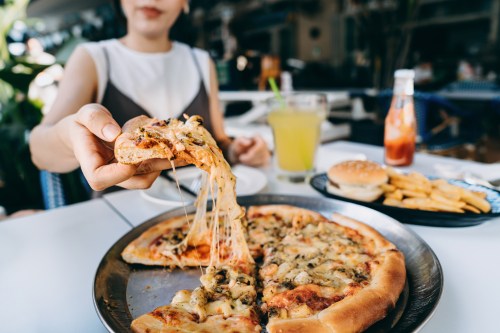Our editors independently select these products. Making a purchase through our links may earn Well+Good a commission
At this point, you’ve probably heard someone in your life—a TikTok influencer, gym bro Tinder date, or maybe even those of us at Well+Good—talk about the importance of getting enough protein to keep your body feeling full, satisfied, and energetic. It has other benefits, too: Protein can help build and repair muscle, support organ function, aid in nail and hair growth, and improve your immune system. Additionally, it’s associated with better physical performance in postmenopausal women1 and is a key part of healthy aging.
Experts in This Article
a registered dietitian based in Denver, Colorado
Despite knowing all the pros, getting enough protein isn’t always the easiest task, however. Rushing out the door, not being in the mood to cook, just wanting a more starchy snack…been there, done that! Interestingly, there’s one meal in particular when many people are especially protein-deficient. Being mindful of and addressing this piece can be a great first step in giving your body the energy it needs.
The meal in question: breakfast.
Why you might not get much protein during breakfast
While dietitians recommend front-loading your day with a hearty breakfast, you’re not alone if that’s not a typical part of your morning routine. “Breakfast can be a really tough meal to get in protein because it can be a really tough meal to eat at all,” says Alyssa Leib, RD, the owner of Peak to Peak Nutrition, LLC. “Breakfast is often the thing that gets skipped in a morning time crunch.” Who has time to whip up a big scramble or make a bowl of oatmeal when you’re running late for work or trying to get your kids ready for the day?
Further, Leib says, a lot of easy, quick American breakfast favorites—such as pastries, frozen waffles, and cereal—aren’t usually high-protein options. Meanwhile, breakfast foods that are high in protein (like eggs, sausage or bacon, and beans) typically require time and effort to prepare.
“It can take some meal planning, intentionality, and time to meet your needs,” Leib says.
“Breakfast can be a really tough meal to get in protein because it can be a really tough meal to eat at all. Breakfast is often the thing that gets skipped in a morning time crunch.”
—Alyssa Leib, RD, Peak to Peak Nutrition, LLC
How to get more protein at breakfast
Thankfully, adding protein to your breakfast dish doesn’t have to be complicated or time-intensive. (We promise!) Leib shares some delicious ideas.
1. Add a quick protein source to whatever you’re craving
The concept of “gentle nutrition”—aka adding nutrient-rich foods without micromanaging your intake—is important here. “When it comes to any dietary change, think about what you can add, rather than take away,” Leib encourages. Some examples she lists are sprinkling cereal over Greek yogurt or topping your waffles with nut butter. (Personally, I’m also a fan of Kodiak’s frozen protein waffles.)
The microwave is your friend here, too. You could heat up these dietitian-recommended pupusas or a Just Crack an Egg bowl kit. Buying (or making ahead) frozen breakfast sandwiches or burritos is a solid option, too.
And don’t forget about protein powder (there are solid vegan options, for the record!). “I always prioritize a food-first approach, but for those extra hard mornings, tossing some protein powder into a smoothie or mixing it into your instant oats will do the job,” Leib says.
2. Prep your breakfasts in advance
Here’s another possible scenario you may relate to: Your mornings are just too busy, but you have a bit of time on Sunday evenings. Whenever that time slot is, consider whipping up some protein-y meals then.
“If cooking eggs takes too much time in the morning, try making egg cups to keep in the fridge and heat up all week,” Leib suggests. “Batch-cook breakfast burritos and keep them in the freezer for a grab-and-reheat meal. Try making overnight oats or chia pudding with all the fix-ins.”
3. Try eating foods you wouldn’t normally consider for breakfast
Food is food! You don’t have to wait until a certain time to eat a certain food.
“Traditional [American] breakfast foods are great, but there is no rule that says you can’t eat tikka masala or tempeh stir fry for breakfast,” Leib says. “Dinner leftovers can make for an easy, balanced breakfast.”
Eating “dinner foods” for breakfast might feel weird at first, but consider giving it a shot. Remember, the most important thing is that you fuel yourself in a way that feels good. And don’t be afraid to incorporate those foods into what you’d consider “breakfast” foods, either. For example, Leib says that beans—which are packed with protein and fiber—can be mixed in with scrambled eggs or blended into a smoothie. “Yes, really—they contribute a creamy texture with almost no taste,” she adds.
4. Plan ahead
Whether you’re rushing to eat or just want a more relaxed morning, planning your breakfasts ahead of time (like at the start of the week) can be another option. “Most of us make around 35,000 decisions each day,” Leib says. “By making a plan, that is one fewer decision you have to make.”
She recommends making a grocery list with breakfast foods that are higher in protein. “Write out what you plan to eat for breakfast each day (and it’s totally fine if you eat the same thing all week) and any steps you need to take to prepare in advance.”
More tasty, protein-rich breakfast ideas
For extra inspiration, Leib got you covered with some of her go-to high-protein breakfasts.
- Tofu scramble with peppers and onions, plus a side of toast
- A bowl with Greek yogurt (or a high-protein, plant-based yogurt, like Silk Greek Style) with peanut butter, granola, and berries
- Smoothies: Some of Leib favorite ingredients include milk or soy milk, frozen cherries, frozen bananas, almond butter, white beans, and chocolate protein powder. You can also make a cinnamon roll smoothie that’s gut-healthy and packed with protein!
- Breakfast burrito with eggs, black beans, roasted potatoes, avocado, and salsa
As with about any health consideration, though, remember to give yourself grace and self-compassion. It’s all about trying and doing your best, not being “perfect.”
As dietitian Ellyn Satter says, “Normal eating is flexible. It varies in response to your hunger, your schedule, your food, and your feelings.”
Gregorio, L et al. “Adequate dietary protein is associated with better physical performance among post-menopausal women 60-90 years.” The journal of nutrition, health & aging vol. 18,2 (2014): 155-60. doi:10.1007/s12603-013-0391-2
↩︎
Sign Up for Our Daily Newsletter
Get all the latest in wellness, trends, food, fitness, beauty, and more delivered right to your inbox.
Got it, you've been added to our email list.










